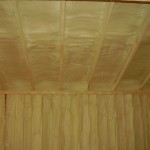
Cathedral Ceiling
As this warm and moisture-laden air comes into contact with the cold surface or cold air in the venting system, condensation occurs. This condensation can lead to mold growth within the batt insulation, as well as other moisture-related problems that affect the underside of the roof, such as staining and rot. These issues can compromise the structural integrity of the roof and pose health risks to the occupants.
To address these challenges effectively, the recommended solution is the application of sprayed polyurethane foam (SPF). SPF offers several advantages in mitigating the problems associated with cathedral ceiling insulation.
Firstly, sprayed polyurethane foam does not support the growth of mold or mildew. This is a crucial benefit as it prevents the proliferation of mold within the insulation, ensuring a healthier living environment. By eliminating the conditions that facilitate mold growth, SPF helps maintain the integrity and performance of the insulation.
Additionally, sprayed polyurethane foam acts as a moisture barrier. When properly applied, it creates a seamless and impermeable layer that seals the warm and moist interior air within the living space of the home. This prevents the air from reaching the cold surface or venting system, minimizing the potential for condensation and subsequent moisture-related problems.
The process of addressing the issues associated with cathedral ceiling insulation typically involves the removal of the existing fiberglass batt insulation. Once the batt insulation is removed, a two-pound closed-cell spray foam is applied to the underside of the roof deck. This high-density foam provides excellent insulation and sealing properties, effectively eliminating air leakage and preventing moisture infiltration.
In addition to treating the roof deck, the two-pound closed-cell spray foam is also applied to the gable ends. This ensures a complete and thorough sealing of the entire system, including the soffit and gable ends. By addressing all potential points of air and moisture infiltration, the SPF application creates a comprehensive and long-lasting solution to the problems associated with cathedral ceiling insulation.
Overall, the application of sprayed polyurethane foam offers a highly effective and efficient approach to resolve the unique challenges faced by clients with cathedral ceiling insulation using fiberglass batts. By eliminating mold growth, creating a moisture barrier, and sealing the entire system, SPF provides improved insulation performance, enhanced durability, and a healthier living environment.
